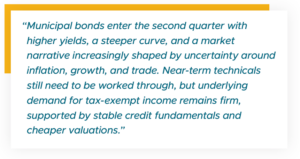Perspectives
Keep
Reading

How Reliant is the Municipal Market on Federal Funding?
Municipal Bond | InsightEven amid recent volatility, municipal bonds continued to behave as you’d expect from one of the more stable corners of fixed income.
Read Article
Municipal Monthly Update March 2025
Municipal Bond | InsightOur team shares insights about recent market events in the Municipal Bond market.
Read Article
The Bond Buyer – Jeff Devine Quoted
Municipal Bond | Press MentionJeff Devine was quoted in a Bond Buyer article, entitled, “Munis firmer, NYC water deal upsized to $950M”
Read ArticleThis Website Uses Cookies
We use cookies to improve your experience on our website. To accept cookies click Accept & Close, or continue browsing as normal. For more information or to learn how to opt out of cookies, please see our cookie policy.
Accept and CloseStay Updated & Informed with GW&K
GW&K's CIO and Portfolio Managers share their insights and opinions on the economy and market each quarter.
-
Latest Insight
How Reliant is the Municipal Market on Federal Funding?
Municipal Bond
Even amid recent volatility, municipal bonds continued to behave as you’d expect from one of the more stable corners of fixed income.
Download -
Latest Market Commentary
State Of The States 2025 — Poised For Fiscal Stability
Municipal Bond
Fiscal conditions across state governments remain healthy as the sector heads into 2025.
Read Article
Municipal Bond Market Commentary – 1Q 2025
Municipal bonds posted negative returns for the first quarter as heavy supply collided with weakening rollover demand late in the period. For much of January and February, municipal bonds held up reasonably well despite the elevated issuance, thanks to strong seasonal flows and sustained demand for attractive tax-exempt income. But that tone faded in March as reinvestment slowed to a trickle and selling pressure picked up ahead of the April 15 tax-payment deadline. The long end took the brunt of the weakness over the quarter, struggling to keep pace with its shorter counterparts, even when the latter were rallying. The resulting curve steepening may reflect a return to more traditional demand patterns, where retail buyers gravitate toward the front end and steer clear of longer-dated maturities. Municipal/Treasury ratios, already stretched entering the year, offered little cushion in the selloff, and headlines around potential tax-policy shifts may have added to the hesitation for some investors.
In the background, Treasury yields offered a window into the broader economic mood—short rates fell sharply as investors leaned into expectations for Fed cuts, while long-end yields declined more modestly, steepening the curve to its widest point in three years. Much of that reflected the market’s struggle to make sense of evolving trade policy, as shifting tariff announcements introduced a fresh layer of uncertainty to the outlook. At times, it seemed clear that tariffs might weigh on growth and pull rates lower. At others, the inflationary implications received more attention, nudging long-term yields higher and dampening conviction around the pace of easing. While market odds for rate cuts increased over the quarter, they did so unevenly, with plenty of second-guessing along the way. The Fed largely mirrored that tension—pausing for now, but reiterating its expectation to cut rates later this year. As the quarter came to a close, trade policy emerged as the key wild card, and markets appeared to be adjusting to the possibility that priorities— and the responses they provoke—can shift without much warning.
Our trading activity in the first quarter focused on locking in higher yields for a longer period of time. For most of the quarter, that meant taking advantage of elevated new-issue supply, selectively participating in deals that offered strong relative value, particularly in call-protected maturities inside 15 years, where spreads and roll potential became increasingly compelling. Roughly 70% of our purchases came from the primary market, which included a wave of large offerings from New York issuers that priced with meaningful concessions. We also found value in electric utilities, hospitals and higher education credits, which priced at spreads that stood out against other offerings. On the sell side, we continued a deliberate effort to rotate out of short-call structures, many of which had performed well in the prior cycle but were increasingly exposed to reinvestment risk. Sales were also concentrated in tight specialty-state holdings, where spreads had compressed to levels that offered little future value for non-resident accounts.
Municipal bonds enter the second quarter with higher yields, a steeper curve, and a market narrative increasingly shaped by uncertainty around inflation, growth, and trade. Near-term technicals still need to be worked through, but underlying demand for tax-exempt income remains firm, supported by stable credit fundamentals and cheaper valuations. Even amid recent volatility, municipal bonds continued to behave as you’d expect from one of the more stable corners of fixed income. The rise in 10-year municipal/Treasury ratios to over 75%, up from around 60% a year ago, has helped restore some of the relative value that had been missing for much of the past year. At the same time, curve steepening reflects both heightened inflation anxiety and a market still anticipating easing on a delayed timeline. Against this backdrop, we remain focused on opportunities to add selectively, especially where recent weakness has improved entry points without altering the long-term case for the asset class.
Disclosures
This represents the views and opinions of GW&K Investment Management and does not constitute investment advice, nor should it be considered predictive of any future market performance. Data is from what we believe to be reliable sources, but it cannot be guaranteed. Opinions expressed are subject to change. Past performance is not indicative of future results.
Indexes are not subject to fees and expenses typically associated with managed accounts or investment funds. Investments cannot be made directly in an index. Index data has been obtained from third-party data providers that GW&K believes to be reliable, but GW&K does not guarantee its accuracy, completeness or timeliness. Third-party data providers make no warranties or representations relating to the accuracy, completeness or timeliness of the data they provide and are not liable for any damages relating to this data. The third-party data may not be further redistributed or used without the relevant third-party’s consent. Sources for index data include: Bloomberg, FactSet, ICE, FTSE Russell, MSCI and Standard & Poor’s.